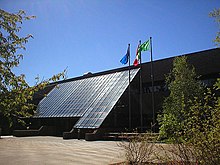Athabasca is a town of almost 3,000 people (2016) in North Central Alberta. It is nestled in the picturesque Athabasca River valley and is the health, education, shopping, and service centre for the region.

Understand

The town is home to Athabasca University, a major centre for distance education and the town's largest employer.
History
Unlike many other towns in Alberta, Athabasca predates the railway. It was the terminus of the Edmonton to Athabasca Landing trail. Athabasca lies on a southern protrusion of the Athabasca River. During the fur trade era, when rivers were the principal means of transportation, the Athabasca–Edmonton trail connected two different drainage basins. The Athabasca River flows north and is part of the Mackenzie River watershed, which leads to the Arctic Ocean. Edmonton lies across a height-of-land on the North Saskatchewan River in the Nelson River drainage basin, which empties into Hudson Bay. Edmonton was in Rupert's Land but not Athabasca. The trail allowed goods to be portaged back and forth between river systems. Once agricultural settlement occurred, the trail served a similar purpose. Eventually, road and rail links would trace the same path.
The Athabasca Heritage Society has put up signs through the downtown as well as along the riverfront that explain and depict the history. It has also published a historical walking tour that is available from the town office, library and visitor information centre.
Get in
By car
It is 145 km (90 mi) north of Edmonton at the intersection of Highway 2 and Highway 55, on the banks of the Athabasca River.
Get around
There is no public transit. Walk or drive.
See
- The Athabasca Heritage Society has a historical walking tour guide on their website.
- The Athabasca train station was built in 1912 on 50th Avenue, the main east-west road through town.
- Amber Valley & Obadiah Place: Obadiah Place is associated with the Africn-American settlement of the Amber Valley area, and two of the community’s leading citizens, Willis Reese Bowen and his son Obadiah Bowen. In 1911, a group of Black Americans emigrated from Oklahoma and filed for homestead on lands north of Edmonton and east of Athabasca Landing. Obadiah Place was settled by Willis Reese Bowen in 1913. Bowen’s log cabin served as a central part of the community, and housed the first post office. The log cabin was replaced in 1938 by Obadiah Bowen, his son, who built the current house.
Do

There are lots of trails for hiking and skiing:
- The Rotary Way at the riverfront is wheelchair-accessible
- Muskeg Creek ski and hiking trails
- The Trans-Canada Trail runs south along the Tawatinaw River and north of the Athabasca River towards the Sawdy district and Smith.
- The Athabasca Landing Trail follows the historic route first mapped out as a Hudson's Bay Company trade corridor. The trail's most popular section is 32 km between Athabasca and Perryvale along the Tawatinaw River. No motorized vehicles permitted. The trail is well signed.
There are opportunities for birding, canoeing, and kayaking.
Buy
Eat
- 49th Street Grill, 4901 - 49th Street, ☏ +1 780-675-5418. 11AM-10PM. Chicken or pork souvlaki; pizza.
- Anne's Fine Dining (Green Spot), 4820 - 51 Street, ☏ +1 780-675-3040. Tu-Su 9AM-8PM. Canadian, Italian, Greek and Irish cuisine.
- Athabasca Burger Bar, 4719 - 50 Street. M-F 6AM-7PM, Su 8AM-7PM. Fast food
Drink
Sleep
- Athabasca Hillside Motel, 4804 - 46 A Avenue, ☏ +1 780-675-5111, toll-free: +1-888-675-8900. 20-room motel built on the side of a hill with a panoramic view of the river valley. Some rooms have kitchenettes. From $70.
- Athabasca Lodge Motel, 4004 - Hwy #2 South, ☏ +1 780-675-2266, toll-free: +1-888-500-2266. Continental breakfast with seasonal fruit included. 32 rooms, air-conditioning, fridge, microwave, LED TV, fitness room, laundry room, kitchenettes, cable TV. $100-140.
Connect
Go next
| Routes through Athabasca |
| Peace River ← Slave Lake ← Jct |
W |
→ Jct |
| END ← | W |
→ Jct N |
